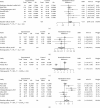Effectiveness of Ecological Momentary Interventions on Pain, Mental Health, and Quality of Life in Individuals With Rheumatic Diseases: A Systematic Review and Meta-Analysis of Randomized Controlled Trials
- PMID: 40766076
- PMCID: PMC12324918
- DOI: 10.1155/jonm/9923240
Effectiveness of Ecological Momentary Interventions on Pain, Mental Health, and Quality of Life in Individuals With Rheumatic Diseases: A Systematic Review and Meta-Analysis of Randomized Controlled Trials
Abstract
Background: Rheumatic diseases are a group of inflammatory conditions that significantly impact physical and mental health. Ecological momentary interventions have shown promising effects among individuals with rheumatic diseases as they can deliver the most appropriate type and intensity of intervention tailored to their needs in real time, but their effectiveness has not been systematically reviewed and examined. Objective: To examine the effectiveness of ecological momentary interventions in reducing pain, improving mental health, and enhancing quality of life in individuals with rheumatic diseases. Design: Systematic review and meta-analysis. Methods: A literature search was conducted in nine electronic databases from inception to April 2024. Randomized controlled trials (RCTs) examining the impact of ecological momentary interventions on pain, mental health, and/or quality of life in rheumatic disease populations were included. Two authors independently screened studies, extracted data, and assessed the risk of bias using Cochrane's bias risk tool for randomized trials (ROB 2). The intervention effect was estimated by calculating the standardized mean difference (SMD) and 95% confidence interval (CI) with R 4.3.3 software. The certainty of the evidence was assessed using the Grading of Recommendations, Assessment, Development, and Evaluation (GRADE) approach. Results: Sixteen RCTs with 1869 participants were included. Ecological momentary interventions significantly reduced pain (SMD = 0.18, 95% CI: 0.04-0.33) and marginally improved quality of life (SMD = 0.29, 95% CI: -0.01-0.60) versus controls. Subgroup analyses revealed greater effects for ecological momentary interventions with daily reminders on pain reduction (SMD = 0.21, 95% CI: 0.06-0.36) and quality-of-life improvement (SMD = 0.45, 95% CI: 0.02-0.88), as well as for ecological momentary interventions involving human contact on pain (SMD = 0.31, 95% CI: 0.10-0.52) and quality of life (SMD = 0.60, 95% CI: 0.25-0.95). However, both the primary analysis and subgroup analyses showed that ecological momentary interventions did not significantly improve anxiety and depression. Conclusion: Ecological momentary interventions could alleviate pain and enhance quality of life in rheumatic disease populations, but had no significant effect on improving mental health. Future research should explore optimizing ecological momentary intervention design and implementation and further examine its effects on mental health outcomes in this population.
Keywords: ecological momentary intervention; mental health; meta-analysis; pain; quality of life; rheumatic diseases; systematic review.
Copyright © 2025 Xiaoxiao Mei et al. Journal of Nursing Management published by John Wiley & Sons Ltd.
Conflict of interest statement
The authors declare no conflicts of interest.
Figures



Similar articles
-
Educational interventions for the management of cancer-related fatigue in adults.Cochrane Database Syst Rev. 2016 Nov 24;11(11):CD008144. doi: 10.1002/14651858.CD008144.pub2. Cochrane Database Syst Rev. 2016. PMID: 27883365 Free PMC article.
-
Cognitive-behavioural treatment for subacute and chronic neck pain.Cochrane Database Syst Rev. 2015 May 26;2015(5):CD010664. doi: 10.1002/14651858.CD010664.pub2. Cochrane Database Syst Rev. 2015. PMID: 26006174 Free PMC article.
-
Physical activity for treatment of irritable bowel syndrome.Cochrane Database Syst Rev. 2022 Jun 29;6(6):CD011497. doi: 10.1002/14651858.CD011497.pub2. Cochrane Database Syst Rev. 2022. PMID: 35766861 Free PMC article.
-
Control interventions in randomised trials among people with mental health disorders.Cochrane Database Syst Rev. 2022 Apr 4;4(4):MR000050. doi: 10.1002/14651858.MR000050.pub2. Cochrane Database Syst Rev. 2022. PMID: 35377466 Free PMC article.
-
Systemic pharmacological treatments for chronic plaque psoriasis: a network meta-analysis.Cochrane Database Syst Rev. 2021 Apr 19;4(4):CD011535. doi: 10.1002/14651858.CD011535.pub4. Cochrane Database Syst Rev. 2021. Update in: Cochrane Database Syst Rev. 2022 May 23;5:CD011535. doi: 10.1002/14651858.CD011535.pub5. PMID: 33871055 Free PMC article. Updated.
References
-
- Jokar M., Jokar M. Prevalence of Inflammatory Rheumatic Diseases in a Rheumatologic Outpatient Clinic: Analysis of 12626 Cases. Rheumatology Research . 2018;3(1):21–27. doi: 10.22631/rr.2017.69997.1037. - DOI
-
- Khallaf M. K., AlSergany M. A., El-Saadany H. M., Abo El-Hawa M. A., Ahmed R. A. M. Assessment of Fatigue and Functional Impairment in Patients with Rheumatic Diseases. The Egyptian Rheumatologist . 2020;42(1):51–56. doi: 10.1016/j.ejr.2019.04.009. - DOI
Publication types
MeSH terms
LinkOut - more resources
Full Text Sources
Medical
Miscellaneous

